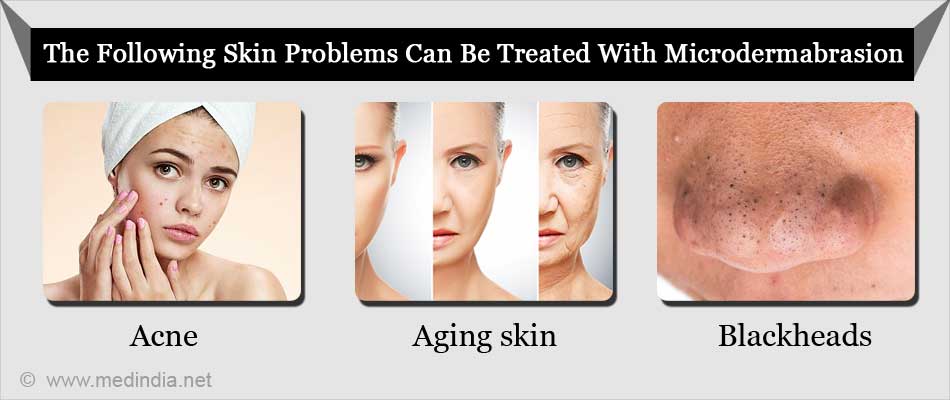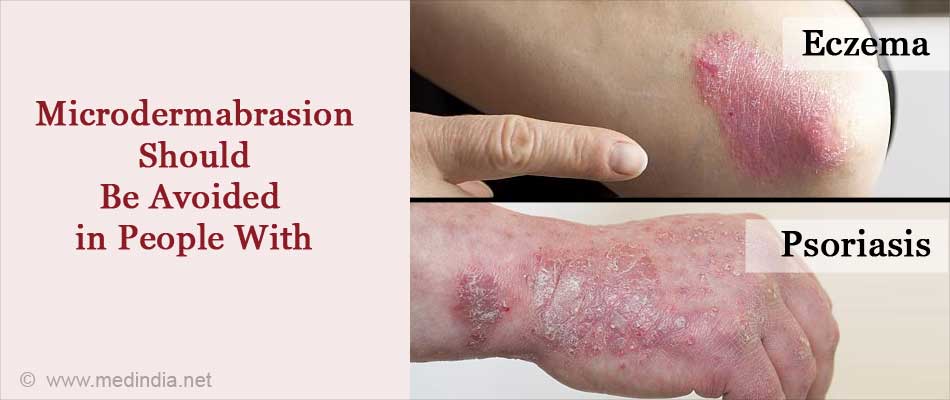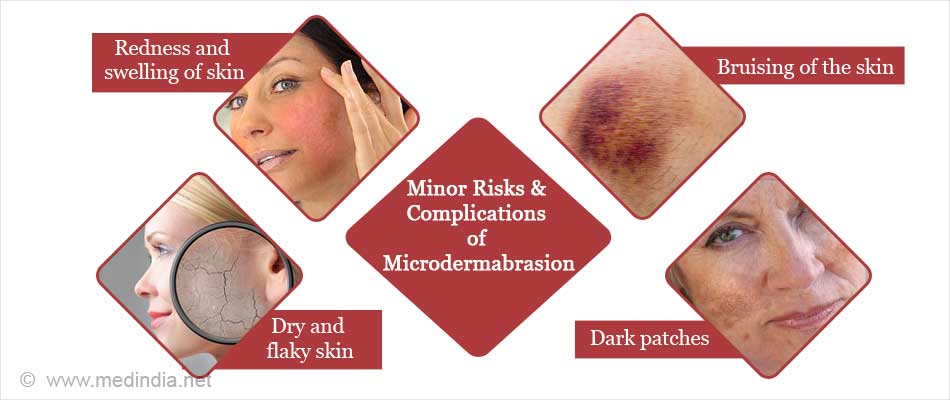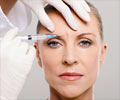- What is microdermabrasion? - (https://www.plasticsurgery.org/cosmetic-procedures/microdermabrasion)
- Dermabrasion - Risks - (http://www.mayoclinic.org/tests-procedures/dermabrasion/basics/risks/prc-20013812)
- Microdermabrasion - (https://www.surgery.org/media/procedure-facts/microdermabrasion)
What is Microdermabrasion?
Microdermabrasion is a simple, cosmetic treatment used to rejuvenate the facial skin by exfoliating the outer layer.
Microdermabrasion is used to reduce facial wrinkles, scars, blackheads and discolorations. It helps to improve the skin’s surface and make it look brighter. Its effects are limited to the topmost layer of the skin called the stratum corneum.
Microdermabrasion involves the use of a hand-held device which removes the outermost layer of dead cells from the skin and, at the same time, applies a mild suction to draw away the dead cells. This encourages the formation of collagen and elastin, leading to an improved and glowing complexion.
Why is it done?
Microdermabrasion is done to get a smooth, healthy and glowing skin. It improves skin complexion and reduces wrinkles in the aging skin.
Microdermabrasion is used to treat the following skin conditions:
- Scars caused due to acne, stretch marks
- Aging skin, to reduce wrinkles, crow’s lines and large pores
- Dark areas of the skin due to freckles or skin blemishes
- Blackheads

Who should not undergo Microdermabrasion?
Microdermabrasion is generally avoided in individuals with the following conditions:
- Skin infection with pus
- Skin that is damaged by radiation treatment or burns
- Recurrent herpes simplex infection
- Warts
- Eczema
- Psoriasis

How does Microdermabrasion differ from other Skin Rejuvenating Techniques?
Other skin rejuvenating techniques differ from microdermabrasion with respect to the following:
Dermabrasion: This rejuvenating technique is more invasive and exfoliates much deeper, when compared with microdermabrasion, which involves peeling off the top 10-20 microns layer of skin. It is for this same reason that, in contrast to dermabrasion, microdermabrasion is not effective on deep wrinkles and scars.
Laser rejuvenation: Laser rejuvenation is yet another technique for rejuvenating the skin. It uses high intensity light emissions to remove the skin imperfections. This procedure is more aggressive on the skin, as compared to microdermabrasion which is a gentle procedure.
Chemical peel: This technique is used to improve appearance of the skin of the face, neck or hands. A chemical solution is applied which causes the skin to exfoliate and eventually peel off. Chemicals like alpha-hydroxy acid and glycolic acid are used to improve the skin texture and complexion.

What are the Common Types of Microdermabrasion Procedures?
There are two common procedures for microdermabrasion:
1. Crystal microdermabrasion: This involves the use of a hand-held device that sprays tiny exfoliating crystals across the skin. Simultaneously, the attached vacuum suctions these crystals back into the device, along with the loosened or dead skin.
The crystals could be of aluminum oxide, zinc oxide, sodium bicarbonate, sodium chloride and magnesium oxide.
Aluminum oxide crystals are commonly used as they are harder and more effective than materials like sodium bicarbonate. Aluminum oxide is an inert material and causes no allergic reactions.
2. Diamond or Crystal-free microdermabrasion: In this alternate approach, crystals are replaced with wands with diamond tips. In this technique, the diamond-tip wand is gently moved across skin to exfoliate.
Diamond tip microdermabrasion is not effective on irregular surfaces as there are no crystals which would otherwise reach the irregular surface.
This technique is more preferred for abrading areas around eyes and mouth, as there is no risk of crystals causing damage or being ingested.
How do you Prepare for Microdermabrasion?
If you wish to get a microdermabrasion done, your consultant or skin specialist will first examine your skin and suggest a treatment plan. The treatment can vary from a single to multiple courses, and may include other procedures along with microdermabrasion.
Before the microdermabrasion procedure, you will be advised to:
- Stop using aspirin for a few days before the procedure
- Stop smoking for around a week before the treatment. This improves the blood circulation of your skin and helps with the healing process
- Stop using retinoid preparations that are used to treat acne, a week before the treatment
- Avoid sunbathing, chemical peels, waxing or collagen injections for two weeks before the microdermabrasion
Male patients should preferably be clean shaven to allow the unobstructed penetration of the crystals during treatment.
What happens during the Microdermabrasion Procedure?
Microdermabrasion is usually an outpatient procedure or is done in specialized salons. It usually involves the following steps:
- A cleanser is applied to ensure that your skin is clean and dry
- Your eyes will be covered to protect them from the crystals
- The motorized device will be passed over the skin. You may feel a slight itching or vibrating sensation during the process, as it involves removing the superficial skin.
- A skin moisturizer is applied to replenish skin moisture and to prevent the skin from becoming dry and start peeling. A sunscreen is also applied to protect your skin.
The treatment may involve multiple sessions, the frequency of which will depend on the condition of your skin. Initially, there could be weekly sessions, followed by maintenance sessions once in two to three months.
What Skin Care is required after Microdermabrasion?
A moisturizer or a facial product, as recommended by your cosmetologist, must be applied for 4-6 days, to achieve effective results of microdermabrasion and avoid excessive peeling
Microdermabrasion increases skin sensitivity; hence, sun exposure must be avoided for at least 7 days, after each exfoliating session. A sunscreen lotion with a high SPF (sun protection factor) must be applied, before going out in the sun.
What are the Risks and Complications of Microdermabrasion?
Microdermabrasion is a very safe procedure. However, there are a few minor risks associated with the procedure, some of the risks are listed below:
- Redness and swelling of skin. The redness usually fades in a day
- Dry and flaky skin, which can be prevented by using a moisturizer
- Bruising of the skin caused due to suction
- Increased skin sensitivity to sunlight. The skin should therefore be protected with sunscreen
- Tiny white bumps which may disappear on their own
- Changes in the skin color resulting in light or dark patches, which are usually temporary
- Infection of the skin

What is the Cost Comparison between Dermabrasion, Microdermabrasion, Laser sessions and Chemical peel?
The costs of various cosmetic procedures vary among centers.
Dermabrasion sessions can cost anywhere between $ 1,500 and $ 4,000. Additional facilities like anesthesia, operating room facility and hospital stay could lead to an additional expense of about $ 4,000.
In comparison, the cost of microdermabrasion would be around $100 to $200, per session.
The cost of laser rejuvenating technique can be in the range of $ 2,000 to $ 5,000 per session.
The cost of chemical peel treatment varies with the condition of the skin and the type of chemical peel desired. The costs can be as low as $150 to as high as $6,000.








